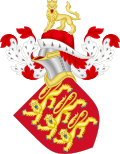| Arms of His Majesty The King in Right of New Brunswick | |
|---|---|
 | |
| Versions | |
 Shield | |
 For use by the Lieutenant Governor of New Brunswick | |
| Armiger | Charles III in Right of New Brunswick |
| Adopted | 1868, augmented 1966 and 1984 |
| Crest | Upon a helm with wreath or and gules within a coronet comprising 4 maple leaves (3 manifest) set upon a rim of water barry wavy azure and argent leaping an atlantic salmon, upholding on its back our Royal Crown, both proper mantled gules doubled Or. |
| Shield | Or, on waves barry wavy azure and argent, a lymphad proper, on a chief gules, a lion passant guardant Or |
| Supporters | On either side a white tailed deer, each gorged with a collar of Maliseet wampum, proper and pendant an escutcheon, that to the dexter bearing our union badge and that to the sinister the arms Azure 3 fleurs-de-lis Or, otherwise France modern. |
| Compartment | Comprising a grassy mount with the floral emblem of the said Province of New Brunswick, the purple violet and young ostrich fern (commonly called fiddlehead) growing all proper. |
| Motto | SPEM REDUXIT [It] has restored hope |
The original coat of arms of New Brunswick was granted to New Brunswick by a Royal Warrant of Queen Victoria on 26 May 1868. [1] The provincial flag is a banner of the arms.


